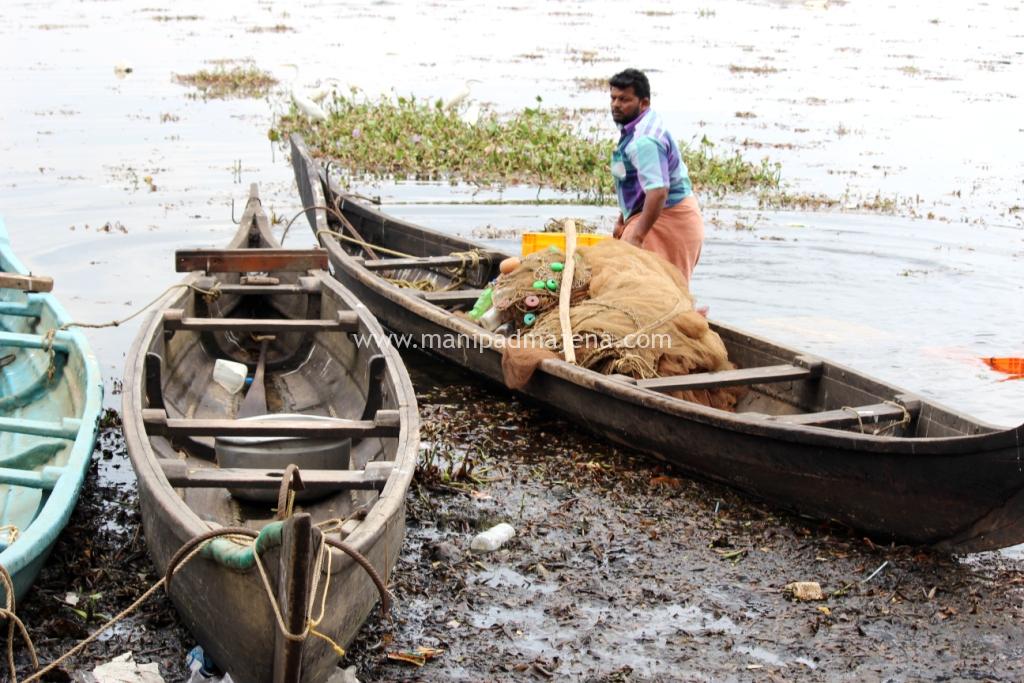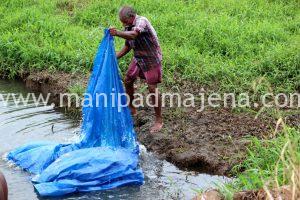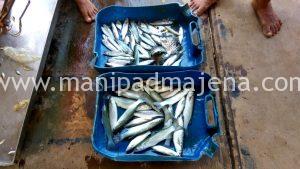
The revival of Pokkali, a traditional salt- and flood-resistant rice and fish farming system in Kerala, requires mechanisation to expand sustainably
As farmers in many regions of India revert tentatively to traditional farm systems to ensure food security in an era of climate change, mechanisation must be given high priority in adaptation projects, say agricultural scientists. Otherwise, these may fail because not only are the soil, sea and rain conditions less dependable now, but socio-economic status and earlier plentiful availability of farm labour also have undergone drastic change.
Pokkali, the centuries-old family farming system producing salt and flood resistant rice and shrimp alternated on the same farms in Kerala’s tidal-water tracts is an example, say scientists.
Although the state government has been trying to revive Pokkali (pronounced Pokkaalli) since 2013 as a climate adaptation strategy, it has not been able to take off as expected.
“Pokkali is a unique form of cultivation. The effort to revive it was received with enthusiasm but interest dwindled because of shortage of mechanization,” Leena Kumari S, senior plant scientist and Registrar of the Thrissur-headquartered Kerala Agricultural University, told indiaclimatedialogue.net.
Some 30 years ago, this traditional rice with shrimp was grown over 25,000 hectares in the waterlogged acidic coastal regions of Ernakulam, Alappuzha and Thrissur districts. In 2015, the area had reduced by 90%. Currently, 2,200 hectares is regularly farmed and 5,000 hectares only occasionally, according to Kerala’s fisheries department.
“Labour is a problem, because much of the Pokkali tract is now located in the Cochin metro area. Here a variety of wage labour is available and traditionally skilled Pokkali farm hands have found regular work at the metro rail line construction,” Leena Kumari said. “The rice production cost is escalating because (during harvest) there is no option but to procure these scarce labourers at high wages.”
“Manual harvesting is very tedious and fewer people are now willing to stand in mud and chest-high water to cut the grain. If not that, then rowing in country boats in the water channels criss-crossing the paddy to get the job done,” she added.
“As October-end harvest time approaches, getting harvesters has become a major headache,” B.K. Kamalahasan, a farmer, told indiaclimatedialogue.net in his Kidangara village farm in Alappuzha district. “Usually women with traditional expertise are the only people who can do this job. Many of them are now old and unable and the younger generation is not interested. They have many earning options including migrating out.”
It has been five years since the 53-year-old decided to give up the family’s four-hectare Pokkali farm in Pattanakkad village to his younger brother. He now traps schools of freshwater fingerlings as they flow into his two-hectare hybrid-rice farm through a narrow inlet from Achenkovil river, growing them alongside the paddies in monsoon for a bit of extra income. Of the 190-hectare Pokkali tract in Pattanakad, only 57 hectares are now in use, Kamalahasan said, quoting government figures.
Climate-smart system
Pokkali fields lie on the edge of Kerala’s backwaters on low-lying lands, watered by both high tides and meandering river channels, water-logged for most part of the year except early summer.
Struggling against several odds including critical shortage of manual labour, only a few hundred traditional Pokkali farmers in Kerala have kept the heritage farming system alive (Photo by Manipadma Jena)
The traditional Pokkali rice plant, experts say, can tolerate salinity equivalent to 6 to 8 grams of salt in 1,000 grams of water. For comparison, seawater has 35 grams salt per 1,000 grams of water. One of the highest salinity tolerant paddy varieties in the world, its gene Saltol quantitative trait locus (QTL) is widely used in international rice labs.
Adapted to a challenging terrain over centuries, it is also tolerant to soil acidity and submergence, which make it very suitable for climate adaptive agriculture. It grows as high as 4.5 to 6 feet. On high tide or river flooding, it holds its grain-bearing head upright above water for up to 10 days, while the plant itself bends over and collapses. Sowing is done on 1.5-foot high soil mounds constructed manually, starting as the heavy southwest monsoon in June flushes out the salt from the land.
In the mid-November harvest, only the grain-bearing portion or top 30 centimetres is cut, and the rest of the stalk is left to decay in the fields. It gives back what it had drawn from the soil and also becomes feed for the young prawns that the high tides later carry in.
By December-end, the Pokkali tracts are ready for prawn filtration — the embankments strengthened against the tides and sluice gates fixed through which the seawater will flush in and out.
Once the prawn larvae and fish are trapped in the fields, they are grown for 3-4 months. Over this period their excrement in an inherently fertile soil provides nutrients for the next rice crop cycle for which no chemicals are needed nor used, as these would harm the prawn.
“The indigenous wisdom of Pokkali cultivation has a great role in maintaining the ecosystem of the farm tracts. It is fully organic, no fertiliser or insecticide is applied, nor is weeding necessary. Success depends on judicious water-flow regulation through the sluice gates,” Thommy Thomas, an 81-year-old veteran farmer of Allapuzha, told indiaclimatedialogue.net.
While the traditional Pokkali rice yield is a low 1-1.5 tonnes per hectare, the income was made up by the prawn and fish yields of 200 to 500 kg from one hectare. Above all, farmers earn through the year with what in earlier years was low investment. Rice research centres in Kerala have since come up with higher-yielding seeds for the saline tracts.
Lure of prawn export
The farmers however had another reason, beyond income, to keep up the brackish-water farming. It was ecological disaster to leave the Pokkali fields fallow because within a few years adjoining sweet-water land too became acidic and fell to ruin while drinking water sources too became brackish.
Eventually, however, this is exactly what happened, reducing regularly cultivated Pokkali fields to merely a tenth of the productive area of three decades ago. Bit by bit the tracts were left fallow, tidal embankment fell to disrepair and seawater came in deeper inland. Or, they were used for growing prawn year-round, converted into coconut farms, or land- use irretrievably changed to build jetties and other infrastructure.
“A few years back we had an attack of bacterial infection (White Spot Symptom) in these prawn farms and exports were hard hit. If year after year farmers go for prawn all the residues and excreta will result in bacteria spread. In the long run, this proves more disadvantageous,” Leena Kumari told indiaclimatedialogue.net. “Profits are only sustainable where the rice-prawn cycle is maintained, because rice crops use up the prawn’s waste, cleansing the soil every year. Farmers must be made aware of this.”
Along with the prawn, brackish water Pokkali farms grow the much-in-demand Pearls Spot and an assortment of other marketable fish (Photo by Manipadma Jena)
There is conflict of interest between paddy farmers and an aquaculture lobby, and people are more interested in growing only prawn because of higher returns, according to Francis Kalathungal of the Pokkali Samrakshana Samithi, an organisation set up to protect the ancient farming system.
Heritage grain’s trade potential
In 2008, in a bid to bring back this heritage variety, which was organic and was packed with protein and antioxidants, sustaining fishers out at sea for a full exerting day. With brown large-sized looks and a flavour uniquely its own, it got a Geographical Indication (GI) status. GI recognition is essentially a trade copyright and helps the designated local producers for higher domestic trade and exports.
The government offers a minimum support price of INR 50 (USD 0.77) for a kilogram of the Pokkali rice, several times the price offered for commercial varieties. Exporters too are ready to pay INR 150 (USD 2.30) a kg, but the current production is not enough to meet either demands. “Pokkali has got GI status but we could not commercially exploit this,” Leena Kumari rued.
Mechanising to revive
During the 2013 rice harvest, the agricultural engineering division of the Kerala Agricultural University piloted a prototype amphibian harvesting machine in Alappuzha, meant specifically for use in inundated Pokkali fields.
“It worked, but it has to be sustainable, not good at a demonstration alone. A lightweight machine but spacious enough to hold the harvest is what is needed,” Leena Kumari said.
In 2015, the university called for tenders for a harvester, specifying a machine 15 ft in length, weighing 1500 kg with a 45 horsepower engine, equipped with hydraulic operated and detachable rake and trailer. Corrosion resistant, rotating rubber chain tracks and a salt water resistant aluminium alloy body able to move at an average six km per hour speed on both water and land were other requirements. Such a machine is yet to be ready.
“It should be able to float, to harvest and to transport the harvested stalks. It is not that easy to develop a machine to these specifications. A lot of effort is ongoing. It could take years,” Leena Kumari told indiaclimatedialogue.net.
Kerala’s fisheries department, which secured INR 337.3 million (USD 5.2 million) funding from the National Adaptation Fund on Climate Change (NAFCC) to restore 600 hectares low lying wetlands for climate-resilient Pokkali and another similar farming system, ignores mechanisation altogether, admitted by most experts to be a major hurdle to Pokkali revival.
On the contrary, the project running through 2016 to 2019 focuses on strengthening stone and earthen embankments on coastal backwater margins to reduce saltwater ingress into farms and, after revival, ensuring more people like olden days are employed in them.
Surviving climate vagaries
The UN Intergovernmental Panel on Climate Change (IPCC) estimates in 2046–2065 (relative to 1986–2005), global average sea-level rise could be 0.17 to 0.32 metres and as much as 33% of coastal land and wetland habitats are likely to be lost in the next 100 years.
The immediate risk for Kerala with a 570 km coastline on the Arabian Sea, and other densely populated coasts, however, are storm surges. In Kerala, high tides can reach over 12 ft in height, according to its disaster management plan.
Coastal intertidal wetlands are one of the most productive ecosystems on earth supporting high biodiversity. In India of the 45 million hectares over which rice is grown, 2.5 million hectares are on coastal saline soils in 11 Indian states.
Of the 100,000 varieties of indigenous rice in India, most have been replaced by a handful of modern hybrids after India’s 1960s green revolution. Those that are still surviving in challenging conditions like Pokkali are proof of the amazing genetic adaptation ability of local landraces and their conservation is crucial for India’s food security, scientists emphasise.
Featured Photo Caption: Part of the climate-resilient Pokkali rice-prawn farming tracts are facing land-use change to informal jetties and other infrastructure (Photo by Manipadma Jena)
Read the original report here: India Climate Dialogue


